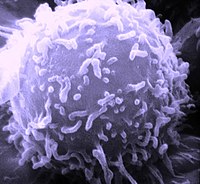
Photo from wikipedia
Prenatal brain development is a highly orchestrated process, making it a very vulnerable window to perturbations. Maternal stress and subsequent inflammation during pregnancy leads to a state referred to as,… Click to show full abstract
Prenatal brain development is a highly orchestrated process, making it a very vulnerable window to perturbations. Maternal stress and subsequent inflammation during pregnancy leads to a state referred to as, maternal immune activation (MIA). If persistent, MIA can pose as a significant risk factor for the manifestation of neurodevelopmental disorders (NDDs) such as autism spectrum disorder and schizophrenia. To further elucidate this association between MIA and NDD risk, rodent models have been used extensively across laboratories for many years. However, there are few uniform approaches for rodent MIA models which make not only comparisons between studies difficult, but some established approaches come with limitations that can affect experimental outcomes. Here, we provide researchers with a comprehensive review of common experimental variables and potential limitations that should be considered when designing an MIA study based in a rodent model. Experimental variables discussed include: innate immune stimulation using poly I:C and LPS, environmental gestational stress paradigms, rodent diet composition and sterilization, rodent strain, neonatal handling, and the inclusion of sex-specific MIA offspring analyses. We discuss how some aspects of these variables have potential to make a profound impact on MIA data interpretation and reproducibility.
Journal Title: Frontiers in Neuroscience
Year Published: 2022
Link to full text (if available)
Share on Social Media: Sign Up to like & get
recommendations!